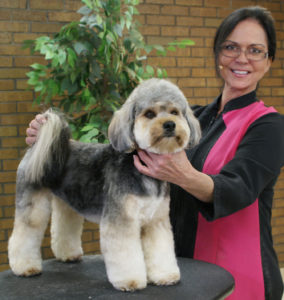
#10 – How to Create a Stylish Salon Trim on a Mixed Breed
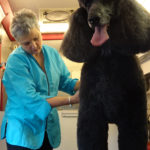

As with all grooming techniques, there are many ways to get the job done.
 When I was a contest groomer, I always did my Poodle cuffs by hand. I would brush the coat down then give it a quick fluff with my comb. Once it was fluffed, I’d glide a long straight shear in and set the lower edge. Then I’d re-fluff and grab my long curved shears to round and bevel the edges. It was time-consuming.
When I was a contest groomer, I always did my Poodle cuffs by hand. I would brush the coat down then give it a quick fluff with my comb. Once it was fluffed, I’d glide a long straight shear in and set the lower edge. Then I’d re-fluff and grab my long curved shears to round and bevel the edges. It was time-consuming.
Done well, the beveled cuffs came out gorgeous. Done poorly, they were a sloppy mess. I had four chances to be perfect with my cuffs – or four chances to really mess up.
For pet dogs, I quickly taught myself another method. It was quick. Fool-proof. And it worked well on most of my shorter stylized pet trims. Read the rest of this entry »
Today was one of those great days. One of those days where something special happens out of the blue. It’s not scheduled. It’s not planned. But when it happens – it just makes you smile.
What happened? It was a simple phone call.
I was racing around trying to get through items on my to-do list. Every time I thought I was getting ahead, something would pop up and get added to the list. I felt like I was on a merry-go-round. It just would not stop. I knew it was going to be a real struggle to get to an appointment I had later in the afternoon.
And then my cell phone rang.
I looked down and saw who was. Dawn Omboy’s name appeared on the screen. That alone brought a smile to my face. I took a deep breath to get myself centered and then answered the phone, “Hello Dawn,” with a huge grin my face.
She was calling for two reasons. One was to thank me for her own personalized copy of Notes From the Grooming Table – Second Edition, which was on the way but had yet to arrive on her doorstep.
The second reason took a little longer to explain, but Dawn promised I was gonna love the story. “Okay Dawn, you’re on,” I thought to myself even though I was pressed for time.
My husband Marc and I had been at Dawn’s salon filming for Learn2GroomDogs.com just a couple of months ago. At the time, she had had the possibility of going to China to teach a clinic on creative pet grooming. Even though it wasn’t a sure thing yet, Dawn was so excited at the possibility! China. She’d never been there – let alone teach there! What an amazing opportunity for a little groomer out of southern Georgia.
A few weeks later we learned that the trip was confirmed and she was leaving the following week! She was so excited and we were thrilled for her. We tracked the trip on Facebook along with so many of her Facebook friends. She looked to be having a wonderful time even though she was traveling solo. (That’s one gutsy move all itself!) She told me she had a blast! Everything was wonderful and the people were so nice even though no one spoke English other than her interpreter – and that was dicey. She still knew it would be an adventure of a lifetime she would cherish.
While she was teaching the creative class, someone asked her if she would show them how to do a German trim on a Poodle. Even though they did not speak the language, she was able to make out what they wanted. And to add to that, they wanted it very full and “fancy.” Okay – she got that. The problem was, she couldn’t remember the last time she had done a German trim on a Poodle! But that was not going to stop Dawn…
Dawn – being extremely resourceful – was not going to disappoint her students, “Of course, she told them, I can show you how to do a German trim!”
 That night she retired to her hotel room. As soon as she got there she hooked onto the Wi-Fi and brought up Learn2GroomDogs.com.
That night she retired to her hotel room. As soon as she got there she hooked onto the Wi-Fi and brought up Learn2GroomDogs.com.
Did we mention she was in China?
She searched the database for German trims and found Judy Hudson had just what she needed on the site. She ordered herself a bit of dinner and spent the evening with Judy Hudson. Via streaming video, Judy taught Dawn the finer points of how to do a German trim on a Poodle.
The next day Dawn was confidently able to demonstrate to her foreign classroom how to do a German trim on a Poodle – all because of Learn2GroomDogs.com and Judy Hudson.
Dawn wanted to make sure I heard the story firsthand from her. I was beaming! I love our Training Partners and I love being able to help others. My dream is to make learning accessible to anybody – anywhere in the world. Between my books and Learn2GroomDogs.com – that dream is coming true. Even as far away as China!
And the best part – Judy Hudson flies in tomorrow for a National Dog Groomers Association of America workshop and testing held at the Paragon School a Pet Grooming (and some special saddle time with a couple Friesians). I can’t wait to relay this story to her, personally.
I cannot thank Dawn enough for sharing such a unique story. It’s amazing what our industry has to offer to anyone who applies themselves. The key is to be the best you can be and share that knowledge with others. Even if you don’t have the education in your head – having the right resources on the fly to locate information will turn you into an instant expert wherever you are.
Happy Trimming!
~ Melissa
P.S.
You never know when you’ll need to be an instant expert! Has this ever happened to you? Go online and tell us about it on the Learn2GroomDogs Facebook page.
February is Westminster dog show month! It is one of the few dog shows getting full national TV coverage at the Groups and Best In Show levels. I look forward to it. Every. Single. Year.
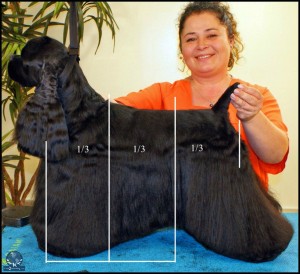 I will be parked in front of my big screen TV for both nights watching and studying.
I will be parked in front of my big screen TV for both nights watching and studying.
This year I’m even more excited. The 140th Westminster Dog Show is coming on the heels of a two-day advanced grooming session we just filmed for Learn2GroomDogs.com.
Master pet stylist, Irina “Pina” Pinkusevich, was our guest Training Partner. Guess what? Just three years ago she won the prestigious Groomer of the Year Award which was presented at the Westminster Kennel Club Dog Show. She worked on six different dogs, all in show trims:
Pina is one of the most advanced educators in our field. Every time I see her work on a dog, I learn something. These lessons were no different. What I especially love about Pina is that she has the inside scoop. She knows the hot styling trends and/or the direction they are going from the conformation show ring.
If you are focused on expanding your career as a high quality pet stylist, it’s more than just washing and knocking the hair off pets. It’s about anatomy. It’s about geometry. It’s about balance. It’s about style. It’s about bringing out the best of a dog based on its written standard. It’s about creating artful illusions. The art of pet styling is sculpting fur.
With every L2GD film shoot, I take detailed notes. With Pina, I find it challenging to keep up. My fingers never stop on my keyboard as I watch her work. I always walk away with loads of notes from her lessons.
Here just three takeaways that I learned from Pina two weeks ago. As I watch this year’s dog show, I will be noticing how these particular trends apply to the dogs in the ring on Monday and Tuesday nights.
I’d never heard this rule of balance, style, and proportions before. Pina said when a dog is in properly balanced, the ratio is ⅔ to ⅓. Two-thirds makes up the front section of the dog. One-third makes up the rear of the dog. When trimming, the tuck-up or front jacket will be placed at the dividing line between the ⅔ and ⅓ points to create proper balance on a dog.
To test the theory, we pulled a number of images of top winning show dogs.
Dang!
There it was there over and over again. I also pulled images of the gorgeously groomed dogs Pina has done for Learn2GroomDogs.com.

Yep… the rule holds true on all of them, too.
This rule might be a new concept to many of us, but it’s been put into practice in the conformation ring for quite some time.
I will be watching to see how this rule plays out on the big screen at the dog show.
What??!

The throat is level with the topline? Seriously? This one caught me off guard. But then I started looking. Really looking. Sure enough. There is was over and over again. It especially held true on the Sporting dogs.
OK, I get it. Level with the back but what if you have a dog with a “sloping topline?” Now where do you take the point of reference from? The loin. It’s the point just in front of the hip bones on the top of the back. Draw an imaginary line from that point level and straight forward to the throat. That’s the lowest point on a clipped throat.
“Huh…,” I thought as I raised a questioning eyebrow. I will be on the lookout for this new grooming development. I saw how the rule held up in the Sporting dog images we pulled – but would it hold up to other breeds in different groups as well? I can’t wait to see how many Sporting Dogs utilize this “rule.” Trust me – I’ll be looking!
Really?!
There is a point of reference when setting this line? Who knew? Certainly not me! I would just eyeball it and pray. My guess is I’m not the only one out there who has used that technique.
This principle applies nicely to many of the Setters and some of the Spaniels in the Sporting Group – as long as they have long enough furnishings to pull it off.
I’ll be keeping my eyes peeled to see if this third rule applies to other breeds, as well.
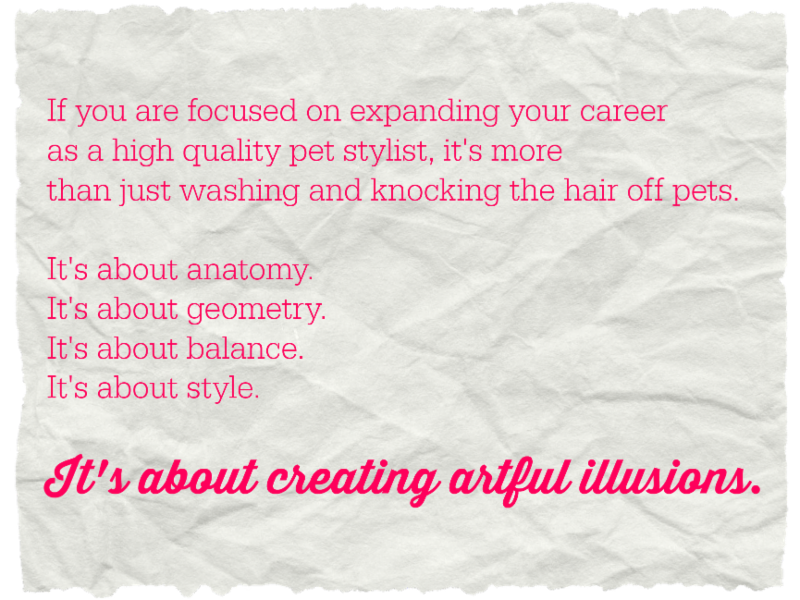 We had many more aha! moments while we watched Pina work her magic on these six lovely dogs. We will be releasing Pina’s latest L2GD video lessons all through 2016.
We had many more aha! moments while we watched Pina work her magic on these six lovely dogs. We will be releasing Pina’s latest L2GD video lessons all through 2016.
The three points I chose to outline here are all points I’ll be looking for closely as I watch this years televised Group and Best in Show classes at the 140th annual Westminster Dog Show.
People say to me all the time, “But I only groom pets… I don’t need to know how to groom show dogs.” You know what? I only groomed pets, too. But that never stopped me from learning as much as I can about what different breeds SHOULD look like. If you don’t have any reference as to what a nice representation of a breed looks like, how are you going to know how to bring out the best of any purebred or mixed breed?
Watching a dog show of this caliber keeps me fresh and excited. Watching top stylists at work, like our Training Partners with Learn2GroomDogs.com does, too. I hope you will join me as I hunker down Monday and Tuesday night to watch the show. I know I’ll have a pencil and paper close by to take notes!
February 15 and 16, 2016 marks the 140th Westminster Kennel Club Annual Dog Show. There are 199 breeds and varieties are eligible to compete. For 2016, there are nearly 3,000 dogs entered. For more information on the dog show, streaming or television schedules go to: http://www.westminsterkennelclub.org/
Happy Trimming!
~ Melissa
P.S.
Did these tricks surprise you? Go online and tell us what you think on the Learn2GroomDogs Facebook page.
As with all grooming techniques, there are many ways to get the job done.
 When I was a contest groomer, I always did my Poodle cuffs by hand. I would brush the coat down then give it a quick fluff with my comb. Once it was fluffed, I’d glide a long straight shear in and set the lower edge. Then I’d re-fluff and grab my long curved shears to round and bevel the edges. It was time-consuming.
When I was a contest groomer, I always did my Poodle cuffs by hand. I would brush the coat down then give it a quick fluff with my comb. Once it was fluffed, I’d glide a long straight shear in and set the lower edge. Then I’d re-fluff and grab my long curved shears to round and bevel the edges. It was time-consuming.
Done well, the beveled cuffs came out gorgeous. Done poorly, they were a sloppy mess. I had four chances to be perfect with my cuffs – or four chances to really mess up.
For pet dogs, I quickly taught myself another method. It was quick. Fool-proof. And it worked well on most of my shorter stylized pet trims.
On most of my pet trims, I cheated off excess leg hair by skimming it with a guard comb. Not only was it fast – it helped me set the length, too. Once I had the legs roughed in, I would brush the leg coat over the clipped foot with a firm slicker brush. I would slide my hand down the leg with my thumb and first finger resting just below the clipper line on the Poodle foot. My fingers would be my guide as I slid in a small pair of detailing scissors (I choose small shears for the safety of my own fingers!). I would scissor all the way around the cuff line, removing the longer hair.
When I released the coat… voila! A perfect cuff for an active pet. I could adjust the fullness of the beveled cuff by adjusting my scissored line somewhere between the lines of the knuckles of the foot and just below the clipped line on the foot. The lower I was on the foot with my cuff line, the fuller the bevel.
 Once my cuff was set, I would neaten and finish the entire leg with shears, smoothing out my guard comb work.
Once my cuff was set, I would neaten and finish the entire leg with shears, smoothing out my guard comb work.
I used this method for years. I even started to incorporate it into my more polished work in the contest ring. It worked well there, too – especially if I used it as a double-check after I did my cuffs with longer shears.
In the past few years, I’ve seen extremely talented stylists start using another method to get perfect cuffs every time. They use a #30 or #40 blade on their clippers! Who knew?
So how do you do it?
It’s very similar to my old method, but instead of shears, pet stylists reach for their cordless 5 in 1 style clipper. They set the blade at the shorter levels, basically the length of a #30 or #40 blade.
Hold the foot off the table at a comfortable level for the pet. With a firm slicker brush, brush all the hair down around the foot. Once the coat is brushed into place, slide your hand down the pet’s leg, thumb and forefinger closest to the foot.
 Stop and hold the foot with your fingers coming to rest right at the clipped cuff line. While maintaining your hold on the foot, gently trim at right angles around the cuff with the #30 or #40 blade. Simply touch the coat at the edge line you want to set.
Stop and hold the foot with your fingers coming to rest right at the clipped cuff line. While maintaining your hold on the foot, gently trim at right angles around the cuff with the #30 or #40 blade. Simply touch the coat at the edge line you want to set.
The fullness of the leg coat will determine where you place the line. For fuller legs, use the top of the crease marks on the toes. If the leg coat is shorter, move the line closer to the clipped cuff line.
When you release the coat, the fur will be nicely beveled. The line should be crisp and free of all stray hairs. As with the hand-scissored cuff, check the work from all angles to make sure the cuffs are level from side to side and front to back. Don’t forget to look from table level when inspecting your cuffs for perfection.
It may take a few tries to perfect this technique, but once you do, creating flawless cuffs every time becomes simple. With a well-prepped dog, this technique is fun, fast, and super safe.
Happy trimming,
-Melissa
P.S.
Do you have any tips to share? Jump over to the Learn2GroomDogs Facebook page and tell us.
For every purebred dog, there is a written standard developed by parent breed organizations that outline what the “ideal” dog of that breed should be. That “essence” is significant for maintaining the proper condition for peak job performance. In other words, to help it be all it can be.
With any purebred dog, there is a “look” or general feeling you want to capture, if possible, while grooming. The trim style can be for the show ring or modified into a pet trim. In either case, you want to pull the “essence” out of the breed standard and apply it the dog.
These are key points from the official breed standard of the Poodle that influences me when I groom and/or evaluate a Poodle trim. The professional pet stylist accentuates or detracts these points according to styling tactics. The more familiar you are with proper canine anatomy, movement, and terminology, the easier it will be to have a positive impact on any pet you groom.
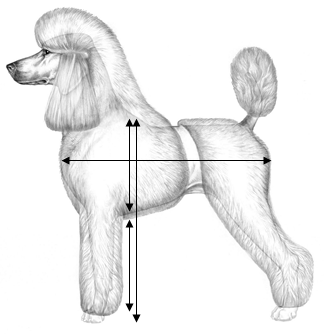 The Poodle
The Poodle
The Poodle is a very stylish, squarely built dog of great intelligence. They have a sophisticated air of distinction and self-esteem. Their athletic and proportionate build allows free, fluid, and elegant movement in their gaits.
The poodle comes in three sizes: Toy, standing below 10 inches; Miniature, standing between 10 and 15 inches; and Standard, standing over 15 inches in height at the withers. A squarely built Poodle should be as long as he is tall from the breastbone to the point of rump and from the highest point of the withers to the ground.
The eyes should be dark and almond shaped. They are deeply set and separated enough to yield an intelligent expression. The ears should be at the same level, or slightly below, the eyes. The cheekbones should be flat. The head of the Poodle should be well balanced with the length of the muzzle from the nose to the stop, being equal to the top skull, from occiput to stop. They have a slight stop that indicates the separation between the muzzle and the top of the somewhat rounded skull.
The neck is long enough to carry the head proudly with an air of dignity. The depth of chest should be equal to the length of leg to create a sense of balance. The legs are straight and parallel when viewed from the front or rear. When viewed in profile, the elbow falls directly below the highest point on the withers. The rear is well muscled and angulated to match the forequarters. The feet are small, pointing straight forward. The ribs are well sprung. The topline is level with a tail set that is high on the rump. The tail should be long enough to balance out the overall portrait of the Poodle.
The coat is curly, very dense, and crisp to the touch. The thicker and curlier the coat, the better it lends itself to a wide range of trim styles. The Poodle can come in any solid color. Their skin tones range from black, brown, and pink, with the lighter colors, normally the more sensitive the skin will be.
Happy Trimming!
~Melissa
Artist Credit: Lisa VanSweden

Sign up to get notified when we host FREE Facebook Live Events!
Thanks! We'll remind you to join our next Facebook Live event!

Sign up to get a reminder when your Members' Only Facebook Live Q&A is about to start!
Thanks! We'll remind you to join our next Facebook Live event!

Join us for our FREE Webinar and get tips, tricks, and the secrets to success from our team of top dog-grooming Experts. We'll send you a reminder email the day of the Webinar.
Thanks! We'll remind you to join our next Facebook Live event!

Join us for our FREE LIVECAST and get inspired by our team of dog-grooming Experts. Learn the tips and tricks other members have used to fuel their success through Learn2GroomDogs.com. We'll send you a reminder an hour before the LIVECAST begins.
Thanks! We'll remind you to join our next Facebook Live event!

From the atmosphere and lay out of your salon, marketing to attract and keep clients, to how many dogs you are going to do that day, Melissa and Joe will help you map out a plan for Success!
Thanks! You will be sent reminder emails and a special link to join the webinar!